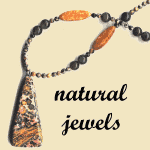
Rocks Used at natural jewels
This is general information about some of the rocks, minerals and fossils that I use to create my jewelry. Most of the rocks I cut and shape myself, although I buy a few of the cabochons if I can't find the rough rock I need. I look for interesting material, which, when cut and polished, becomes thecentral pendant in a necklace. Many times the rough rock won't look like much, but when cut and polished becomes gorgeous.
Agates and jaspers
Agate
and jaspers are part of the chalcedony group of minerals which are a
microcrystalline variety of quartz (can't see the crystals with the
naked eye.) They form in cavities of rocks or lava from silica rich
solutions which percolate down through the cracks in the rocks. The
unbelievable variety of colors and patterns depend on the minerals which
are dissolved in the silica solution.
Both agates and jasper have a hardness of near 7, with 10 being the hardness of diamond. Agates are usually translucent and jaspers are usually opaque, although sometimes the line between a jasper and an agate is in the eye of the beholder.
The names of agates and jaspers usually depend on the predominant color or pattern or the locality of the rock. For example Biggs jasper is named for the area in which it was found, whereas bluelace agate is a descriptive term for that particular color and pattern.
Malachite
Malachite(right) is a rich green mineral found in the oxidation zone of copper deposits (hydrous copper carbonate). The malachite used in lapidary work usually forms in a mass similar to a stalactite with concentric color banding. Its beauty is valued not only for jewelry, but as a carving medium for small objects. Malachite is often intermixed with azurite, which is also a copper carbonate of an intense blue color. Both of these minerals are soft, usually 3.5 to 4 and need to be worked carefully.
FOSSILS
Fossils are remains of organisms found inside the rocks of the earth's
crust. In the process of fossilization, the soft parts of an organism
decompose while the more durable parts such as bones, teeth or shells
are able to last longer and can be fossilized. Fossilization occurs
when these harder parts are replaced by minerals saturating the water
environment where most fossils are formed. We then say that a fossil
is replaced by agate or "agatized", or replaced by opal or
"opalized". Other common minerals which compose fossils include
pyrite and calcite and other forms of chalcedony.
Chrysocolla is one of the copper minerals and is similar in color to turquoise. The type of chrysocolla which is used for lapidary work is mixed with translucent chalcedony. The chalcedony gives gem chrysocolla the hardness needed to be cut and polished without crumbling. Sometimes, the chrysocolla is mixed with green malachite, or dark blue azurite to produce a beautiful mixture of colors. Chrysocolla is one of my favorite minerals to work with, as the range and mix of colors is unending.